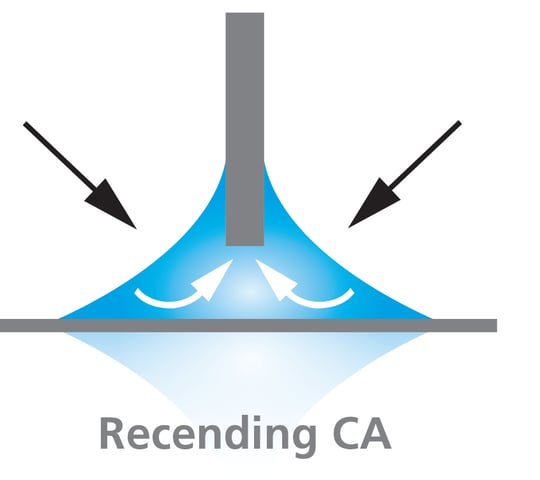
In modern wettability characterization, it is often pointed out that measurement of static contact angle is not enough due to their inability to present real properties of the surface. Most typically measurement of advancing and receding contact angle is encouraged. In our previous post, we have already discussed the advancing contact angle while in this post we are concentrating on receding one.
A Receding contact angle is the lowest possible contact angle on a given surface. The receding angle is measured on a previously wetted surface.
The receding contact angles are measured when the liquid front is receding over the surface to be measured. This can be done in different ways with an optical tensiometer such as tilting the sample or decreasing the volume of the droplet while at the same time recording the contact angle values. Receding contact angles are also measured with force tensiometers with the Wilhelmy plate method by withdrawing the sample from the liquid and measuring a force by extremely sensitive balance.
On a chemically heterogenous surface, the receding angle is more sensitive to the high-energy components i.e. polar parts of the surface. If the receding water contact angle is measured on a primarily hydrophilic surface, the hydrophobic inclusions from the surface will not affect the receding contact angle value until they cover a significant portion of the hydrophilic surface. On a hydrophobic surface, the receding water contact angle quickly decreases to a lower value even if the surface is only slightly covered with the hydrophilic inclusions. The value is also not much affected even with an increasing fraction of the hydrophilic components.
Receding contact angles are easily affected by surface roughness. If the advancing contact angle is below 70 and the surface is rough, close to zero receding contact angles will likely be measured on that surface. This means that on these kinds of surfaces, the receding angle is not able to give much of an insight into surface chemical composition but can be used to evaluate the level of roughness.
To characterize superhydrophobic surfaces, the receding angle is more meaningful as it will also evaluate the roll-of-angle. The requirement for a superhydrophobic surface is higher than a 150-degree contact angle and low roll of angle. Over a 150-degree receding angle will alone guarantee these requirements.
Contact angle hysteresis can tell you about the homogeneity of your surface coating.
One should always measure the advancing and the receding contact angle to get the true picture of the surface wettability.
Due to a wide range of applications, the measurement of wettability, i.e., the contact angle measurement can be done with several different methods.
More and more research interest is being put on functional coatings. New measurement techniques are required to evaluate them.
Contact angle hysteresis is often measured with so-called tilting cradle or plate method. The measurement can be done either manually or automatically.
Dynamic contact angle measurements with the needle method has been automated for reliable and repeatable results.
Contact angle hysteresis can be measured with optical (needle and tilting methods) and force (Wilhelmy method) tensiometers.
Contact angle hysteresis (CAH) is an important physical phenomenon. When you look through the window on a rainy day, you have probably noticed that some of the water droplets stick to the glass even though gravity is pulling them down. The phenomenon can be explained by contact angle hysteresis.
